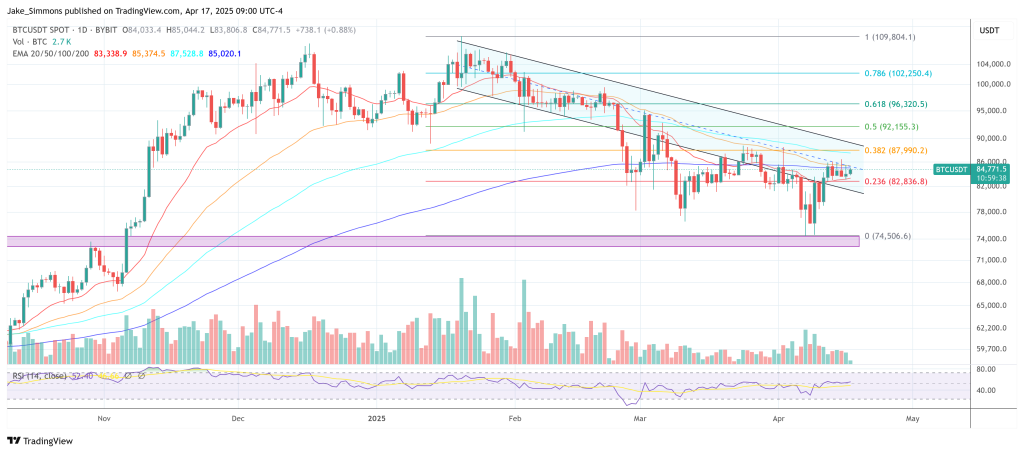Collective with quantum division known as Project Eleven threw a public glove to the global cryptography community, offering the one Bitcoin prize of the first team, which can be deliberately broken down the version of the Bitcoin elliptical cryptography using the genuine quantum computer before April 5, 2026.
By announcing what he calls the “Q -Day award” on the X, group wrote: “We have just launched the Q -Aday award. 1 BTC for the first team that broke the toy version of Bitcoin’s cryptography using a quantum computer. Date: April 5, 2026. Mission: Protect 6 m BTC (over USD 500).” Post crystallizes the problem that floats on the Bitcoin ecosystem for over a decade: the possible arrival of huge, convoluted errors of quantum equipment capable of running the SHORA algorithm against the keys of the real world.
The Eleven project does not ask the participants to smash the 256 -bit Bitcoin curve. Instead, teams must demonstrate the Sorra algorithm against elliptical keys, from one to twenty -five bits – the size of mockingly called “toys” by professional cryptographers, but still orders of greatness except what was publicly achieved on physical quantum processors. The organizers say that even a three -sea break would be a “great news” because it would provide the first quantitative verification point of quantum progress on the problem of a cautious elliptical log (ECDLP). In their words, “no one strictly compared this threat.”
To qualify, the application must contain code at the goal level or open instructions launched on actual quantum equipment, as well as the narrative of the methods used, the errors and the required classic after processing. Hybrid attacks that are based on classic shortcuts are not allowed. All entries will be published, a decision that the group defines as an exercise in radical transparency: “Instead of waiting for a breakthrough that will happen behind closed doors, we believe in facing this challenge, in a transparent and rigorous way.”
Why 1 bitcoins – and why now?
Bitcoin safety is ultimately based on the hardness of the discrete logarithm problem compared to the SECP256K1 curve. While classic attacks scale the exponentially, Peter Shora quantum algorithm from 1994 can fundamentally solve the problem during the multi -core time, collapsing the cost from the cosmic to only gigantic. Current research estimates that in the order of two thousand fully fully determined by Kubit error – perhaps supported by millions of physical cubs – they would be enough to threaten the 256 -bit key. Companies such as Google, IBM, IONQ and Newcomer Quera are racing to exceed the four -digit logical threshold – although none of them publicly showed something similar to this ability.
The Eleven project claims that his reward is smaller as a reward, and more as diagnostics. Over ten million Bitcoin addresses with over six million coins have already revealed their public keys through previous expenses. If quantum technology exceeds the critical threshold before these coins are migrated to quantic addresses, the funds would be susceptible to immediate theft. “Quantum calculation is constantly developing,” warns the group. “When this happens, we must know.”
The initiative lands among the wave of quantum proposal to resign in a wider bitcoin ecosystem. At the beginning of this month, a group of programmers sent a quantum protocol of address migration (QRAMP), a proposal to improve Bitcoins, which would organize the entire network to transfer to key formats for quantum. Because Qramp would require a ponderous fork, his political perspectives remain uncertain.
A separately Canadian startup BTQ has issued an exotic evidence alternative called the sturdy -grained sampling of Bozon, which would replace today’s mining puzzles based on hash -based hoofs based on hash photonic extraction made on quantum equipment. Like QRAMP, the BTQ concept requires a challenging fork and has not yet collected wide support.
From a technical point of view, maintaining up to a five -bbitic version of the Sorra algorithm is brutally ruthless: cubicits with loyalty above 99.9 %would be required. Serving errors to correct errors combines engineering load, which means that candidates will probably have to utilize logical cubic and impressive compilation techniques only to maintain noise under control.
However, the prize may be irresistible for university laboratories and corporate research and development teams, willing to demonstrate a practical quantum advantage. Cloud devices from the IBM quantum system. Whether any of these machines can maintain the necessary circuit depth.
Each result provides invaluable data. According to the premiere of the Eleven project, the goal is Stark: “He broke the largest ECC key with the SHORA algorithm. Prize: 1 BTC + Go down in the history of cryptography.”
During the BTC press it traded at USD 84,771.

A distinguished painting created from Dall.e, chart from tradingview.com

Editorial process For a bitcoinist, she focuses on providing thoroughly examined, correct and impartial content. We maintain strict acquisition standards, and each page undergoes a careful review of our team of the best technological experts and experienced editors. This process ensures the integrity, importance and value of our content for our readers.
